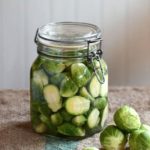Fermented Brussels Sprouts
Fermented Brussels sprouts are salty, sour and tangy. Perfect as a side dish or diced up as a condiment. See the section above for 5 different flavour options.
- Prep Time: 10 minutes
- Total Time: 10 minutes
- Yield: 1 quart 1x
- Category: Side Dish
- Method: Fermented
- Diet: Vegan
Ingredients
Units
Scale
- 1 Tbsp salt (non-iodized)
- 1 cup chlorine-free water (enough to cover)
- 1 lb of Brussels sprouts.
- Flavors (see the section above)
Instructions
- Mix the salt and water in the bottom of a 1-quart (1 L) jar.
- Decide if the Brussels sprouts are going to be fermented whole or in half. I don’t recommend doing a mix of both because they won’t ferment at the same rate. See the section above for more details.
- Don’t use any sprouts with bad spots. Slice a little bit off the bottom of the sprouts. Peel off any loose leaves. Wash the sprouts and pack them into the jar.
- Add more water if necessary to completely submerge the sprouts. Use a weight to keep the sprouts below the brine and leave 1-inch of headroom.
- Cap with a loose-fitting lid that will allow gas to escape. See notes for more details.
- Ferment in a cupboard for at least 2 weeks and up to 6 months (for whole sprouts).
Notes
- I generally like using fido jars for my ferments. However, I don’t have enough fido jars for all my ferments so I often use mason jars and simply don’t tighten the jar ring all the way. You could also use an air-lock or pickle-pipe. Using a good, fermentation-specific lid is more important for longer ferments. So I recommend it if you want to ferment whole Brussels sprouts for longer than a month.
- Like sauerkraut and other cabbage ferments, fermented Brussels sprouts are not recommended for anyone with hypothyroidism.
